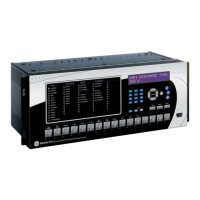5-250 C70 CAPACITOR BANK PROTECTION AND CONTROL SYSTEM – INSTRUCTION MANUAL
GROUPED ELEMENTS CHAPTER 5: SETTINGS
5
When the “CTxR (grnd)” value is selected, the measured bank neutral point voltage is shifted by 90° lagging to compensate
for the angular difference between the bus neutral voltage and the voltage derived from the bank neutral point current.
Choose the value of resistor R so the voltage measured by the auxiliary input of the relay matches bus V0 during system
faults (for example, an SLG fault at the bus). This is accomplished by the following condition:
Eq. 5-22
where
V0
BUS
is the bus primary zero-sequence voltage during system fault
3I0
NTRL
is the primary current in the bank neutral during system fault
n
BUS_VT
is the bus VT ratio set in the source selected by the NTRL VOL UNBAL 1 BUS SOURCE setting
n
NTRL_VT
is a neutral point VT ratio set in the source selected by the NTRL VOL UNBAL 1 NTRL SOURCE setting. If R can be
chosen precisely, then n
NTRL_VT
can be set same as n
BUS_VT
. If R cannot be chosen precisely, then n
NTRL_VT
is used to match
zero-sequence voltage as per the equation above.
n
NTRL_CT
is the CT ratio in the bank neutral
NTRL VOL UNBAL 1 AB RATIO — This setting compensates for the bank inherent unbalance. Physically this value is a ratio of
the reactance in phase A divided by the reactance in phase B. Auto-setting procedure is available under the Commands
menu to calculate this value automatically. When tuning this setting manually, after bank repairs, this ratio shall be
increased or decreased from the nominal value of 1.00 depending on whether the A or B phase got affected by failures or
repairs and whether a given reactance increased or decreased as a result of the failure or repair. Use this setting only when
the
NTRL VOL UNBAL 1 BUS 3V0 setting is set as “Calculated.”
NTRL VOL UNBAL 1 AC RATIO — Compensates for the bank inherent unbalance. Physically this value is a ratio of the
reactance in phase A divided by the reactance in phase C. Auto-setting procedure is available under the Commands menu
to calculate this value automatically. When tuning this setting manually, after bank repairs, this ratio shall be increased or
decreased from the nominal value of 1.00 depending on whether the A or C phase got affected by failures or repairs and
whether a given reactance increased or decreased as a result of the failure or repair. Use this setting only when the
NTRL
VOL UNBAL 1 BUS 3V0
setting is set as “Calculated”.
NTRL VOL UNBAL 1 STG 1 PKP to NTRL VOL UNBAL 1 STG 1 PKP — Specify pickup thresholds for stages 1 through 4 of the
function in per-units (pu) of the nominal value of the neutral-point VT (the auxiliary channel of the neutral source).
NTRL VOL UNBAL 1 STG 1 SLOPE to NTRL VOL UNBAL 1 STG 4 SLOPE — Specify the slopes of the operating characteristic.
Neglecting compensation for the inherent bank unbalance, the operating signal is a vectorial difference between the
neutral point voltage and the zero-sequence bus voltage. Therefore, the optimum restraining signal is a vectorial sum of
the two signals. During external ground faults, the two voltages are approximately in phase generating a large restraining
signal being twice the zero-sequence voltage at the bus. A slope of few percent is typically sufficient to provide good
security under large system unbalances. If a given stage is used with a time delay longer than the expected external fault
duration, the slope may be reduced or eliminated. In general, the slope can be understood as a adaptive threshold, and the
user is provided with three ways to control sensitivity and security: pickup, time delay and slope. See the Application of
Settings chapter for information.
NTRL VOL UNBAL 1 STG 1 PKP DELAY to NTRL VOL UNBAL 1 STG 4 PKP DELAY — Specify the pickup time delays for each stage of
alarming or tripping. Each of the four comparators (four stages) uses an individual pickup timer, but a common drop out
time delay as specified by the next setting.
NTRL VOL UNBAL 1 DPO DELAY — Controls a drop out delay for the operate FlexLogic operands. Note that individual stages
apply individually configurable pickup delays, but use this common drop out delay.
NTRL VOL 1 BLK STG1 to NTRL VOL 1 BLK STG4 — These settings are used to block the function when required on a per-stage
basis. At minimum this function shall be blocked when the bank is off-line, or else it will operate unnecessarily during
external ground faults and/or natural system unbalance if set sensitive. Either breaker position or undercurrent indication
via any available instantaneous overcurrent function, or a combination, may be used for blocking. Note that when
unblocked, the function becomes operational after five cycles of intentional delay. Optionally only the sensitive stages are
blocked, and one stage set high enough to ride through possible problems is left operational. This stage can be used for
abnormal conditions such as a failure of one pole of the breaker to close. The function becomes blocked if all four blocking
inputs are asserted. The individual blocking inputs inhibit the associated stages of the function.

